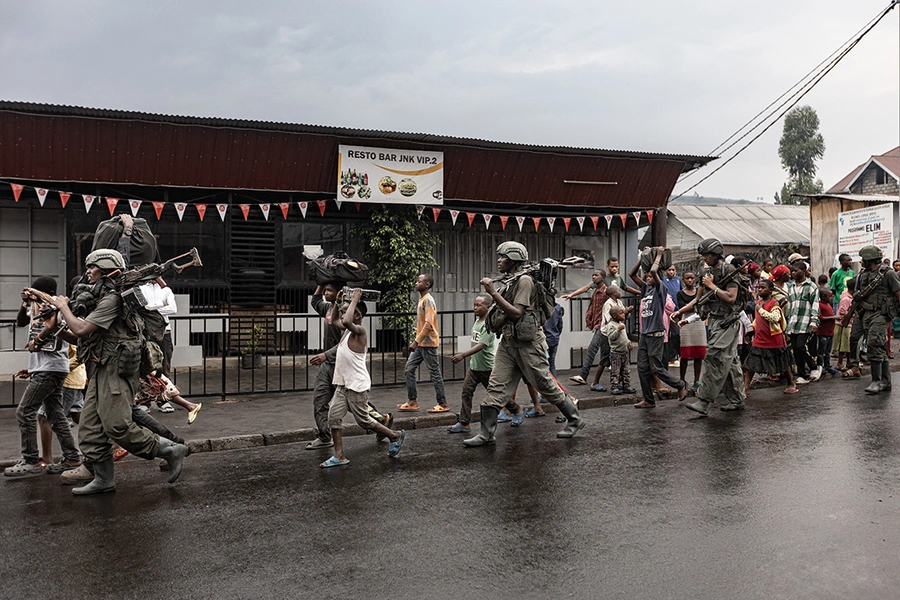Understanding the Ongoing Conflict in Goma, DR Congo
The eastern region of the Democratic Republic of Congo (DR Congo), rich in minerals, has experienced persistent conflict for over three decades, a situation deeply rooted in the aftermath of the 1994 Rwandan genocide. The power struggle between numerous armed factions and the central government has led to extensive violence, drawing in neighboring countries and triggering catastrophic consequences, particularly during the 1990s when two major conflicts, referred to as Africa’s World Wars, resulted in millions of fatalities.
Recent Developments in the Conflict
The resurgence of violence in 2025 has garnered fresh attention, particularly with significant territorial gains made by a rebel faction known as the M23. After capturing several critical cities, there are now discussions surrounding a potential peace treaty. The M23’s pivotal move came at the end of January with the seizure of Goma, a North Kivu city with a population exceeding one million. Situated on the border with Rwanda and adjacent to Lake Kivu, Goma plays a crucial role as a commercial and transport hub and is closely linked to mining areas rich in valuable resources.
In February, the M23 escalated its military activities by taking control of Bukavu, the capital of South Kivu province. Tensions remain high as the M23 continues to engage in confrontations with the Congolese army, aiming to expand their influence across the region. At one point, the M23 even expressed intentions to advance towards Kinshasa, the nation’s capital situated over 2,600 kilometers away.
The M23 Rebel Group
The M23 is predominantly led by ethnic Tutsis who claim they have taken up arms to advocate for the rights of their community. They assert that past agreements aimed at resolving the ongoing strife have been disregarded. Taking their name from a peace accord signed on March 23, 2009, the M23 was formed in 2012 and quickly gained territory, including Goma, leading to widespread international condemnation and accusations of human rights violations. Although they were eventually expelled from Goma by Congolese forces and UN intervention, the group was later integrated into the Congolese army based on promises of Tutsi protection. However, the M23 resumed hostilities in 2021, alleging that these assurances had been broken.
Rwanda’s Involvement
The group’s leader, Sultani Makenga, is a Congolese Tutsi with a background in the Rwandan military. While the Rwandan government has consistently denied supporting the M23, various reports from UN experts since 2012 have claimed that the country has provided weapons and logistical assistance to the rebels. Observations from the Congolese government, as well as the U.S. and France, further reinforce accusations of Rwandan backing for the M23. A recent UN assessment indicated that as many as 4,000 Rwandan troops may be engaged alongside the M23.
Rwanda maintains that its troops are stationed along the border to prevent the spillover of conflict and blames the fighting on the Congolese government’s refusal to negotiate with the M23.
Ethnic Tensions Rooted in History
The origins of the ongoing violence can be traced back to the atrocities of the 1994 Rwandan genocide, during which close to 800,000 individuals, largely from the Tutsi demographic, were murdered. Following the genocide, many Hutus fled to what is now DR Congo, exacerbating ethnic animosities. The ongoing activities of certain Hutu groups in eastern DR Congo, like the Democratic Forces for the Liberation of Rwanda (FDLR), only complicate the situation further, as Rwanda perceives these militias as a continual threat.
Recent Peace Negotiations
Recent weeks have seen renewed efforts to establish peace, spurred by months of unsuccessful mediation led by Angola. On March 18, discussions between Congolese President Félix Tshisekedi and Rwandan President Paul Kagame resulted in a call for an “immediate ceasefire.” Following this, both DR Congo and M23 agreed to suspend hostilities until peace talks in Qatar reach conclusive agreements. A similar accord was signed on April 25 between DR Congo and Rwanda, affirming mutual respect for sovereignty and aiming toward a potential peace blueprint.
The Resource Conflict
The mineral wealth of DR Congo is a significant factor in the prolongation of this conflict. Reports illustrate that Rwanda may be leveraging the ongoing battles to extract Congolese resources, including gold and coltan, a key component in electronics. The M23 has seized valuable mining territories, leading reports to indicate that approximately 120 tons of coltan are being transported to Rwanda every month. While Rwanda refutes allegations of resource exploitation, the DR Congolese government is pursuing a minerals agreement with the U.S. as part of efforts to stabilize the situation.
| Key Events | Dates |
|---|---|
| M23 captures Goma | End of January 2025 |
| M23 seizes Bukavu | February 2025 |
| Ceasefire call between Tshisekedi and Kagame | March 18, 2025 |
| Agreement to halt fighting until talks | April 23, 2025 |
| DR Congo and Rwanda agree on sovereignty | April 25, 2025 |
As the international community watches on, the pressing need for a resolution to the ongoing conflict in DR Congo remains critical, both for the stability of the region and the welfare of its citizens.


